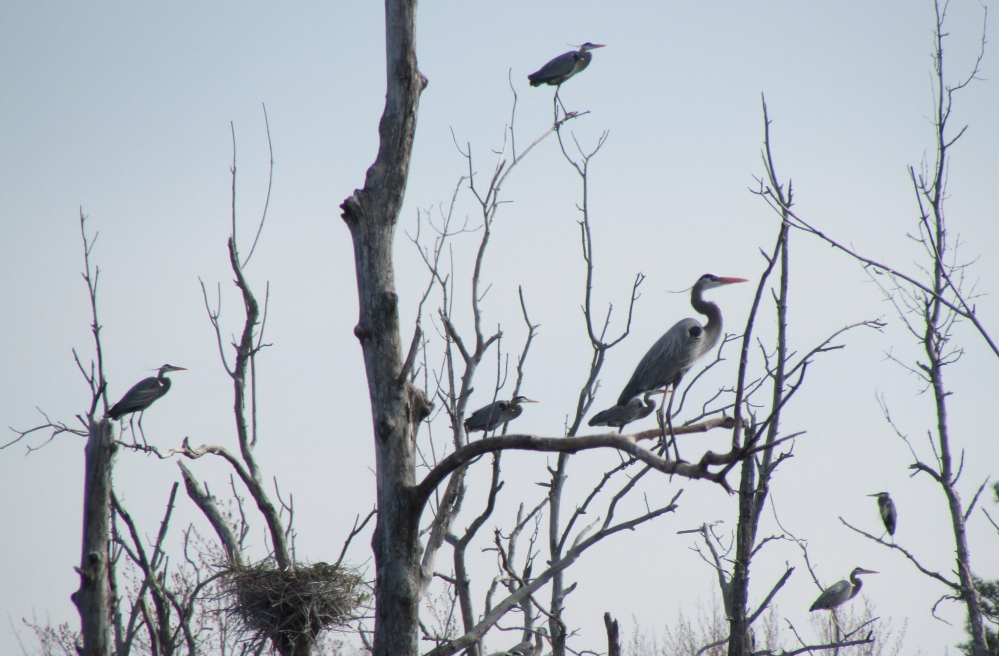BENTON — It takes a journey down an unmaintained dirt road and through dense thickets of woods and underbrush to reach the great blue heron colony.
As one descends through the brambles on the downward slope of a small hummock, the first nest comes into view, with one of the adult herons protecting it. It takes only a minute more of carefully picking through the brush to reveal the entire colony — more than 30 huge nests, surrounded by dozens of herons, topping dead trees in a freshwater marsh surrounded by conifers. More of the birds circle the aviary from the sky, sometimes landing on slim branches with surprising grace.
Rick Lawrence has been coming to the aviary for the last seven years to monitor the herons and record how many are nesting at the site. He quietly sits on a log at the edge of the marsh with binoculars and a notebook, counting individual birds and sketching out the location of nests. A light clattering sound fills the air, produced by the birds snapping their bill tips together, a form of communication.
This year Lawrence counted 35 nests, making the Benton colony what is believed to be the biggest inland colony in Maine and one of the largest colonies in the state.
But it’s not an official title, since it isn’t clear how many heron colonies there are in Maine or what the size of the state’s heron population is.
In 2009, Danielle D’Auria, a wildlife biologist for the Maine Department of Inland Fish and Wildlife, started Maine HERON, a volunteer science initiative aimed at mapping Maine’s great blue heron population.
The program was sparked by concern about the decline of historically large colonies on Maine’s coastal islands, D’Auria said. It is estimated that those colonies have declined 60 percent to 65 percent since the mid-1980s.
“We really didn’t know if that was happening statewide, or if the numbers had gone up or down or stayed the same,” D’Auria said.
Great blue herons are wading birds that can stand 3 feet tall and have a wingspan of up to 6 feet. It’s common to see them standing still as statues along freshwater streams and lakes, waiting for the moment to strike at fish or amphibians.
But even though they aren’t uncommon, herons are considered a species of special concern in Maine. That means that while not threatened or endangered, the birds are particularly vulnerable and easily could become more at risk.
The suspected decline is attributed partially to a rebounding bald eagle population, D’Auria said. Eagles nest in the same areas and prey on young herons and even adults.
However, eagles don’t account for the entire decline, D’Auria said. Researchers still aren’t certain what role changes in food, habitat or other environmental factors might play in the population’s health.
“It’s more of one big question mark at this point,” D’Auria said.
But through the volunteers, the state has been building up a population baseline that can indicate the strength or weakness of Maine’s herons in the future.
Since its launch, the network has grown to more than 250 volunteers who, along with DIFW staff, are monitoring colonies across the state during the nesting season, from April to July. D’Auria estimated that in 2014 there were 105 active colonies and 1,091 mating pairs statewide.
Survey results have been fairly stable since the beginning of the study, especially in the inland colonies, which are concentrated largely in central Maine. Coastal colonies tend to shift around more often, making it hard to keep track of nesting pairs, D’Auria said.
Although the volunteer effort is critical, it has its limits. Some people don’t participate every year and some colonies are hard to reach, D’Auria said.
This year researchers are conducting an airborne survey of suspected nesting sites, in hopes of fleshing out site data and discovering new colonies.
“This year is probably one of our biggest efforts ever,” D’Auria said.
Back in Benton, Lawrence finishes up his count and packs away has materials.
He is careful to tread softly around the colony. With too much intrusion, the location might become too threatening for the herons. Also, there’s always the chance that the old trees finally will break in a winter storm, and the great birds will leave for another place.
“I always dread coming back some year to find they’ve all moved out,” Lawrence said as he walked up the hill, away from the marsh.
Peter McGuire — 861-9239
pmcguire@centralmaine.com
Twitter: @PeteL_McGuire
Send questions/comments to the editors.





Comments are no longer available on this story